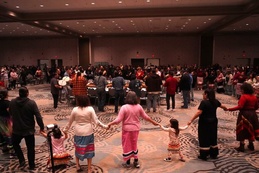Bata Turns the Corner
With Loop and Link, Traverse City’s bus service has become a viable alternative for more commuters
March 23, 2014
 The Bay Area Transportation Authority (BATA) has come a long way since its days of operating dial-a-ride buses that scooted around Traverse City seemingly empty.
The Bay Area Transportation Authority (BATA) has come a long way since its days of operating dial-a-ride buses that scooted around Traverse City seemingly empty. Significant financial and organizational changes have increased ridership and pulled the agency out of debt, with enough cash in reserve to keep the system running for months.
Out of nowhere, it seems, Traverse City has a real mass transit system.
BOTTOM LINE TURNAROUND
In 2008, BATA lost $357,000 and was $400,000 in debt. Cash flow was $20,000, about enough to keep buses running for half of a day.
BATA’s funding comes from four sources: a five-year millage passed in 2012 which provides 37 percent of the budget; state funding which provides 36 percent; and federal funds which cover 16 percent, said Matthew Powis, BATA finance director.
The rest – 11 percent – comes from the fare boxes.
"We could maybe operate until noon if they stopped funding," said Carrie Thompson, BATA’s business director.
In 2009, Tom Menzel became the authority’s executive director after a successful three-year stint running the National Cherry Festival.
That year, BATA made $157,000. In 2010, the agency paid off all of its debt.
By 2012 they had enough cash in reserve for buses to run for three months.
LOADS OF NEW TECHNOLOGY
Anyone who has been a regular rider of BATA has noticed lots of changes, from the way the buses are painted and routes are marked to the way the fares are collected.
BATA is still just catching its breath from all of the recent technology that’s been added, paid for through grants, Menzel said.
They’ve gotten surveillance cameras on buses to cut down on liability and so that drivers can concentrate on driving. They’ve installed mobile data terminals and electronic fare boxes. They’ve redesigned the buses and route signs so the system is easier to use.
Mobile data terminals will be able to monitor on-time performance and BATA will be able to analyze how many and what kind of riders are getting on at each stop.
Menzel said he is excited about the capabilities the organization now has to analyze ridership and improve service.
"It’s been a real challenge for an organization that was in the 1970s to come up to 2013 and "˜14 within 18 months," he said.
"˜NOT A GOD-GIVEN RIGHT’
New programs have also come online to increase efficiency and slash fraud.
For example, riders now have to apply to get a reduced fare card. Students, senior citizens and the disabled are eligible.
"Before that, I’ll give you one example," Menzel said. "One run we had about 169 people everyday. We never had more than 10 full-paying passengers. People would get on and say, "˜Oh, I’m disabled. Prove I’m not.’ The first day we instituted that, [there were] 59 full-paying passengers."
They’ve established no-show penalties for dial-a-ride users who can now get barred from the system for repeatedly not taking rides they’ve called for.
Before that policy BATA never kept track of no-shows, which are costly because they cause buses to make trips for nothing.
In the first few weeks of the policy, BATA counted 127 no-shows.
"Public transit is not a God-given right; it’s a responsibility for them as well," Mezel said. "If they want us to have a good system that’s fair and equitable, and gives the taxpayers a good return on their money, there has to be responsibility on the ridership."
Another change was the electronic fare boxes. The boxes were clear and had a slot for tickets and money. People would deposit anything: washers, Jamaican coins, tokens from Chuck E. Cheese.
"A rider could essentially get on with a fist like this and just dump it," Powis said. "If it makes a noise after they release, there’s no way to determine what they put in there."
Now cash and cards are validated when inserted into the electronic fare boxes.
"You can’t cheat," Menzel said. Revenues increased by 11 percent.
CHANGES ATTRACT RIDERS
"We literally have changed every aspect of this organization," Menzel said. "Basically it started as a rural transit agency, where most [transit authorities] start as urban and then branch out. So it was in reverse."
Some new features at BATA have been specifically designed to attract new riders.
They’ve offered shuttle service during festivals. They’ve offered the bike-and-ride route to Suttons Bay for people who want to try out the Leelanau Trail but only want to ride one way. They are considering a bikeand-ski service.
"It can’t just be for any niche market.
It’s public transit," he said. "We need to have a system that the mother with two kids in Slabtown, who wants to go to the Open Space, has the ability to use that in a convenient, timely manner."
LESS DIAL A RIDE, MORE FIXED ROUTES
Bus ridership in Traverse City has been on an upward trend, surpassing national averages.
From 2003 to 2013, BATA provided 52.5 percent more rides; from 2010 to 2013, ridership increased 20.6 percent.
Most importantly is that the proportion of riders on fixed-route Loop buses has increased relative to dial-a-riders, or Link riders.
In a decade, those percentages roughly flipped – in 2003, 40 percent of riders took fixed-route buses and 60 percent called dial-a-ride. By 2013, 60 percent were on a fixed-route.
What’s more, the changes BATA enacted last May when the Loop and Link routes were rolled out seem to already paid off.
If numbers hold steady through the end of fiscal year 2014, riders on fixed-route buses are projected to total 83 percent of riders.
The new system of Loop and Link buses was designed so that people in rural areas could still call a dial-a-ride bus for a ride to the nearest stop on the Loop, rather than a ride to their destination or to the Hall St. hub.
Menzel said he hopes to make BATA operate more like an urban transit service. The more riders that opt for fixed routes, the more the bus fares can cover the organization’s bottom line.
CHANGES CAUSE PUSHBACK "¦ FOR NOW
The new policies caused "lots of noise, Menzel said, because the of pushback from riders who didn’t want to change. But he believes that will be temporary. BATA has studied the aftermath of big changes at other mass transit systems.
"What we’ve found is, after it’s in about six to nine months, no more problems," Menzel said.
Menzel said he also had to get buy-in from the employees as well.
"If the drivers, dispatchers and mechanics don’t buy into the change process, organizations will sabotage it," Menzel said.
Menzel and his team scrapped the organizational chart and rewrote all of the job descriptions; everyone had to reapply for their jobs. Employees took a BATA-created customer service training program.
Menzel renegotiated the union contract and got some big concessions, like a clause that the loser has to pay in arbitration battles, which makes the sides more cautious before starting fights. Also, pay increases are now based on profitability.
"So the driver who used to let the bus run for 30 minutes turns it off now, because he can see the bottom line," Menzel said. "It’s precedent-setting labor agreement, but it’s based on being successful and everyone shares in it."
FEWER MILES; MORE SERVICE
So what has changed for the person who lives, say, 15 miles out of town and several miles off of a main road?
"They can still get a ride. The thing is, they have do it in an available time slot. And we have quite a few of those," Thompson said. "So the difference for them is instead of us picking them up at their door and taking them all the way down to the Hall Street transfer station, we are going to pick them up and take them to the closest fixed route, and that’s how you get into town."
They also have to arrange the ride 24 hours ahead of time so that pickup service can be better coordinated.
Powis said the number of buses operating as dial-a-ride buses have been reduced from 13 to six.
In fact, the new structure has reduced the total miles buses have to travel to get riders to their destination.
"You can feed into the system and work your way down to wherever you want to go, so it’s much more efficient," Menzel said. "The result was much more consistency in the system, but also we saved about 55,000 miles [per year] and a hundred and some thousand to the bottom line, so the result was, without increasing cost, we increased our service for three hours each night, and added weekend service for the first time."
HOPES ROUTES DON’T CHANGE
Susen Love had been a BATA rider for years, using buses to get to shops or her doctor’s office.
"It’s been pretty good," she said. "There for a while, they always had a problem with being on time, but it’s not that way anymore, at least on this type of route."
Love said she is a bit nervous about the plan to revise the city Loops this year based on feedback from users, neighborhoods, employers, and the data about BATA use.
"They’re going to change the routes again, they said by fall. We’ll see," she said. "Right now they’re working well."
The system isn’t perfect. It’s based on a series of compromises which enable the routes to spread out around Traverse City. Depending on where you are and where you want to go, it may look ingenious or difficult to use.
For instance, Love lives in an apartment near Meijer on US 31 South. To get to the mall, she takes the Meijer/Oleson’s bus to the Hall Street station and transfers to a Grand Traverse Mall bus. That means, even though the mall is just more than a mile away from her apartment, it takes her an hour of bus travel each way to travel there.
She hopes the routes don’t change, though.
The route nearest her home travels by Munson Medical Center, so she can currently get to doctors’ appointments without having to transfer.
"I just hope when they change it again, they don’t change the route that I am on," Love said.
REPUTATION IMPROVED
Gary Vidor, who started with BATA in 2010 as a driver and is now a trainer, drove some of the popular bike-and-ride routes to Suttons Bay last summer and said he was delighted to see how enthusiastic people were to ride a BATA bus.
"You just didn’t hear a lot of good things about it [in the past]," he said. "Today, I have friends who ride it all the time and say it’s changed to such a user-friendly system."
Vidor has lived in Traverse City for 30 years and said he is familiar with the reputation BATA used to have.
He said the changes have been tough, but he has also noticed improvements that have come as a result.
"I actually came in here in the early stages of the changes. I’ve been through a lot of it," Vidor said. "I think the state of the company is greatly improved."
Trending

Winter Break at the Library
Trying to keep the kids busy while school is out? Head to the library! Dec. 22, take your 12+ tweens and teens to the Mesick… Read More >>
Umbo Is Coming...to The Little Fleet
Winter isn’t just coming—it’s already here. But if you want a break from the December blues, head to The L… Read More >>
GTB Starting the Year with Tradition
The Grand Traverse Band of Ottawa and Chippewa Indians hosts the Kchi Wiikwedong Anishinaabek Maawnjidowin Round Dance on Ja… Read More >>


